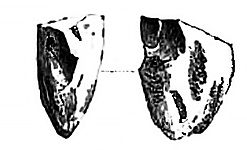A mutilated tomahawk, with a beautifully-curved cutting edge (Fig. 187), was obtained by Major Couchman when engaged in surveying Pental Island, on the River Murray. It is a fine granular—nearly dense—quartzite.
A small tomahawk obtained from the Yarra tribe (Fig. 188) is rudely fashioned from a block by striking off flakes. The cutting part is well ground and polished, and when fitted with a handle it must have been a handy and useful instrument. The rock is aphanite, and the axe is only three inches and a quarter in length. Its weight is seven and a quarter ounces.
 |
 |

|
| FIG. 187.—(Scale ¼.) | FIG. 188.—(Scale ¼.) | FIG. 189.—(Scale ¼.) |
A very small greenstone axe, found in the neighbourhood of Kilmore (Fig. 189), has a polished cutting edge; but the edge itself is much chipped and jagged, perhaps because the grinding and polishing were never completed, or because of rough usage after completion. Its weight is three ounces. Its length is only two inches and a half, its breadth in the broadest part less than two inches, and its thickness no more than three quarters of an inch. This is the smallest tomahawk in the collection.
In Fig. 190 is shown a tomahawk of greenstone (resembling serpentine), roughly shaped by chipping, and partly ground in one part. It was found in the neighbourhood of the quarry at Lancefield, where stone suitable for these implements was in former times dug out by the natives. It appears to have been partly formed, and then, being found unsuitable, thrown away by the natives. Its weight is ten and three-quarter ounces. It is interesting as showing the form which these implements presented after chipping, and before being ground and polished, and affords a notion of the immense labor the natives must have bestowed in giving to a roughly-chipped axe the proper shape and polish. To shape this fragment into a good axe would, without mechanical appliances, require the hard labor of many days.
 |

|
| FIG. 190.—(Scale ¼.) | FIG. 191.—(Scale ¼.) |
Another roughly-shaped axe (Fig. 191) was found in the same locality. No attempt has been made to grind or polish it. The upper part appears to have been accidentally broken off, probably when chipping it. The material is a metamorphic siliceous sandstone (knotted sandstone).
